Chinese Camellia
Description and Characteristics: The Chinese Camellia (Camellia sinensis) is an elegant and captivating flower with a long history and profound cultural significance. It is an evergreen plant that is used to produce tea leaves. Chinese Camellias typically thrive in warm and humid climates, preferring semi-shaded environments. Their flowers are usually white or pink, with graceful … Read more





